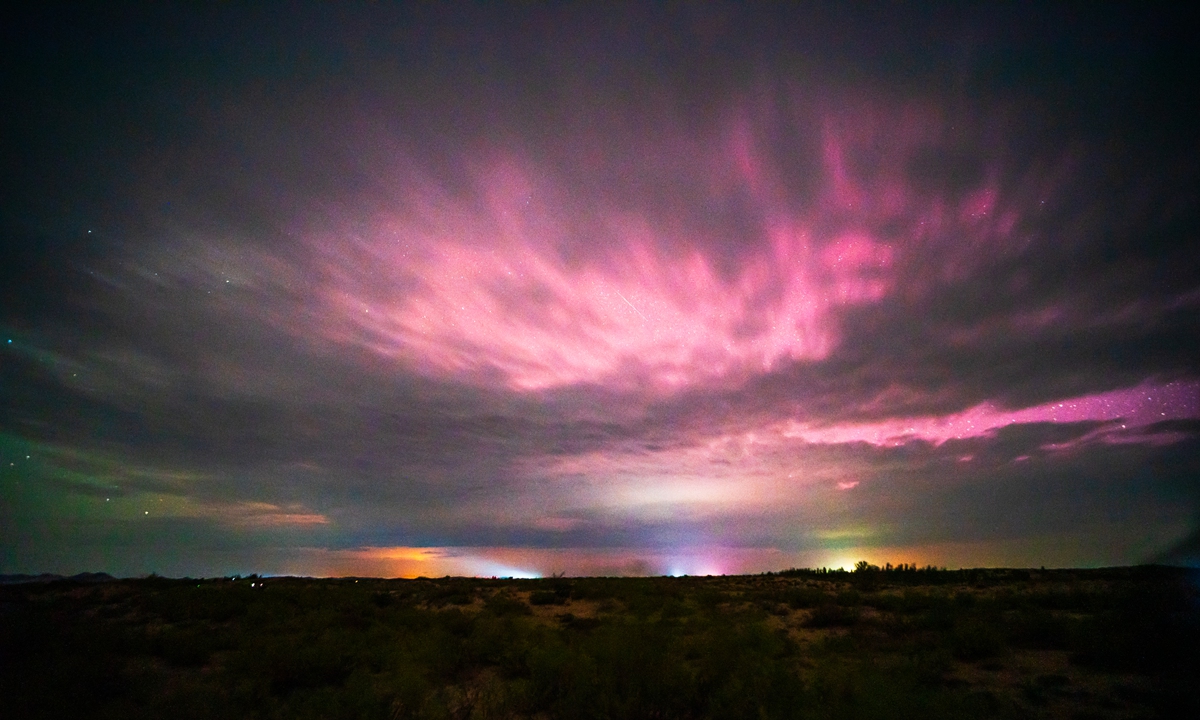Stunning Aurora Lights up the Sky across China as Solar Storm Hits Peak Year

An aurora is seen on the outskirts of Chifeng city, Inner Mongolia Autonomous Region, May 11, 2024. Photo: VCG
On the early morning of Saturday, a geomagnetic storm brought a breathtaking gift to China -- the aurora borealis lit up the skies across various regions of the country, attracting visitors and photographers to enjoy the stunning beauty.
At 9:32 am on Saturday, the National Space Weather Monitoring and Early Warning Center under the China Meteorological Administration issued a red alert for geomagnetic storms, predicting moderate to high solar activity levels in the next three days, with the possibility of M-class or even X-class flares, leading to small to large geomagnetic storms, and even severe geomagnetic storms.
Regions such as Altay in Northwest China's Xinjiang Uygur Autonomous Region, Mohe in Northeast China's Heilongjiang Province, and North China's Inner Mongolia Autonomous Region were among the best destinations to witness natural phenomenon.
Altay, located in the northern part of Xinjiang, became a hotspot for tourists and photography enthusiasts eager to witness this natural wonder. The night sky was adorned with colorful auroras, creating a mesmerizing spectacle for all who gazed upon it.
As people stepped out of their homes at night and looked up at the sky, they were treated to a display of colorful auroras dancing across the night sky, creating a dreamlike atmosphere. The auroras, like a magical gift from nature, captivated onlookers, leaving them spellbound.
With its cold climate and high altitude, Altay has become a prime location for aurora viewing in recent years, drawing tourists from both domestic and international destinations.
Also in Mohe, located in the northernmost part of China, the night sky was illuminated with vibrant shades of purple and red, attracting tourists from far and wide.
One such tourist, Ma Jingxuan from Beijing, embarked on a road trip to Mohe specifically to witness the mesmerizing display of red auroras. "I drove all the way from Beijing and finally caught a glimpse of the northern lights. It was absolutely beautiful and awe-inspiring," Ma exclaimed as he captured the magical moment with his camera, the Guangming Daily reported on Saturday.
This year, Mohe has witnessed multiple occurrences of the northern lights, drawing in visitors from all corners of the country.

A red and purple aurora lights the night sky in Changji, Xinjiang Uygur Autonomous Region, May 12, 2024.Photo: VCG
Interestingly, the phenomenon of the northern lights even extended as far south as Beijing on Saturday. Photographer Wang Kai seized the opportunity to capture the enchanting moment in the capital city, a local Beijing media outlet reported.
Experts predict that parts of Beijing and Hebei may witness the northern lights again on Sunday. They recommend observers to head to the northern mountainous areas of Beijing such as Yanqing, Miyun, and Huairou districts for the best viewing experience, away from light pollution and with a clear, open view of the sky.
According to a diagram from magazine Chinese National Geography, the color of the aurora varies depending on the distance from the observer. Red auroras are typically seen at distances greater than 300 kilometers, while green auroras are more common at distances between 100 to 200 kilometers. The closer one is to the aurora, the more vibrant and colorful the display becomes.
Meanwhile, in other high-latitude regions around the world, the stunning phenomenon of the northern lights has also been making appearances. From northern Switzerland to Dublin, Ireland, and various locations in the UK, the night skies have been painted with hues of green, red, and purple, creating a magical and ethereal atmosphere for all those lucky enough to witness it.
The ongoing solar storms are expected to continue to be active in the next two days, allowing for the possibility of widespread auroras in the northern hemisphere.